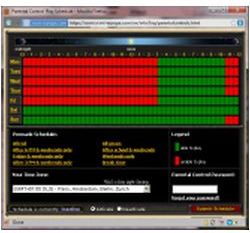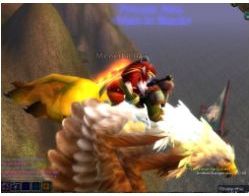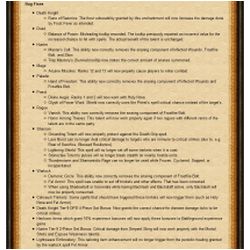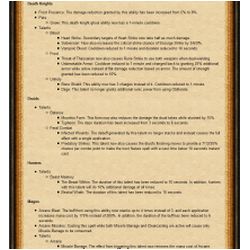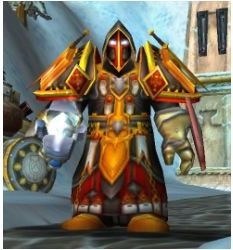... The Bad, ...
... The Bad, ...... The Bad, ...
There a lot of good things to say about World of Warcraft, but not everything is hugs and kittens. Now, let's first look at what there is for a parent to be apprehensive about in the game.
Virtual Time Sink
Like any non-trivial game, World of Warcraft takes time to play. How much time is really up to the player (or the player's parents as the case may be). There is no denying that WoW can become quite a time sink. It takes time to level, gather materials to sell or make into needed items, run instances, complete quests and do research. Some instances are quite short, taking only an hour or two. Others are very long. As an example of the extreme, there was one instance I did with a random group (called a "pick up group" or "PUG" - borrowing the same from basketball) that is usually done in three parts. That is, it's usually run three separate times. This particular group did very well on the first part and decided to run the whole thing in one sitting. I was sitting for a little over six hours. One of the major complaints players had about WoW was how long instances were taking, so in the last expansion, the new instances where constructed such that bosses that could be done in shorter times and individually over several days if necessary.
There are ways parents can control how much their child plays. Starting up WoW requires logging into a WoW account with a user name and password. Younger players don't need to know what that password is to play their characters even if they switch between them, so a parent can logon to WoW and turn it over to their child to continue. If the player logs off or communication drops and the player is logged off automatically by WoW, it can become tedious for the parent to have to go back to the computer and type in the password every time. It would not be a problem in my house as connection problems are rare with my Internet Service Provider, but that not the case for every household.
Another way to control game playing time is to use the parental controls provided by Blizzard for its games. (It used to be just for WoW, but now appears to cover all Blizzard games. A login may be required to see that page.) These are used to set the times that the game may be played by day of the week and hour of the day (in half hour increments). This schedule is given a separate password (and email address) from the account's password so even if your child knows the account password, they can't change the schedule. Unfortunately, this schedule is set for the entire account rather than individual characters, so if the parent would like to play after junior (or juniorette) has gone to bed (and it's outside the scheduled hours), the best approach is a separate account. One reason that the schedule is set on the account - not on the game installed on your computer - is so that junior/juniorette can't just go to a friend's house to "study" and play their character from there. Clever folks those Blizzard programmers. Additionally, the game has a command - /played - that can be typed into the chat text window to get the total number of days, hours and minutes played on that character. (The number of "days" is the number of 24 periods played - most likely not contiguously.) Parents can ask to see these numbers periodically to see if they are increasing unexpectedly.
Unfortunately, some quests are just plain tedious and time consuming. I found the newer the quest is (i.e., those that occur in later levels in expansion packs as opposed to the original ones in the original portion of the game), the less likely this was to be the case. Blizzard has reworked a lot of the older quests as well. If a player is trying to get 20 of something from some animal along with 15 other players that just happen to be doing the same quest at the same time, this can take quite a while. Time management comes into play here. If your child complains about a quest taking too long, encourage them to either drop it or come back to it later. WoW does keep track of the rate at which items are being collected in a certain area and dynamically changes the rate at which those items "spawn" (i.e., get created again). Even with this, if an item is being over-farmed at a given time, it may not be enough. There are just so many quests though that (you or) your child should always have others to do instead.
Mom! I Can't Quit Right Now!
Most parents have probably heard a similar lament from their child when they ask them to quit a game to go to bed, come to dinner or do their homework. In some games, it's a hollow complaint because they can stop and save anywhere without losing any progress or achievements. In World of Warcraft, unfortunately, that is not always the case. It is true that a player can log out of WoW at any time or place. (The game does have a short countdown if a player logs out when they are not in a "safe" area such as a town.) The world in WoW is always live and active even if your child's character isn't playing. If your child just managed to battle their way through a bevy of baddies to advance in a quest, they won't want to stop and log out at that point. If they do, everything they've just managed to defeat will likely be back when they log back in. (This is called "respawning" in WoW.) It's likely that they will re-enter the game standing on or near one of the game's computer-controlled characters (called "NPCs" for Non-Player Characters) who will immediately start attacking (as will any other nearby NPCs). That generally ends badly. No WoW player likes to have to repeat the effort to get back to where they were in the progression of a quest.
That last paragraph only looks at the problem from the standpoint of playing alone. It's worse if your child is with a group in an instance. It can sometimes take a long time to get a group formed, and if the instance is new to the group, it can take a while to make their way through. Nobody likes to have to quit in the middle of an instance, and other players don't appreciate it when another player quits before the end. If it happens often, your child may find it hard to get invited to a party because of their reputation of not seeing it through to the end.
Even with the above caveats, the facts in WoW are: a player can quit anywhere and anytime in the game if they have to. Every player can "hearth" (teleport) directly from any place inside WoW to a safe spot at any time (although there is a time limit to how often they can do that - and a countdown until the limit ends). Before allowing your child to play WoW, set the ground rules for questing and "raiding" in a party or group. Starting a quest with less than a half hour or a raid with less than an hour before their time ends should be discouraged. Along with the parental controls, children will learn how to cope. If they've got only 20 minutes left, they can log out early (Gasp!), gather some extra raw materials for whatever profession they've chosen, browse the auction house or (at the higher levels) do one of the short, repeatable daily quests to get in-game gold. The game does not lend itself to having a player quit at a moment's notice, but it can be managed fairly well.
Pests
PestsPests
I mentioned above that one of the positive things about WoW is the ever-present community. As a parent of a child, you might be apprehensive about the other people your child will meet in the game. From my experience, the vast majority of other players are just out to have fun, too. The chat text is usually fairly lighthearted and fun. Unfortunately, as in any public place there are those "less-than-desirable" characters. WoW does have a language filter option so that certain words in the text chat windows are bleeped out with "#!^*@!%&@" type substitutions. A player can add any other player to their ignore list so that anything that player types in a chat window isn't seen at all. Individuals that repeatedly cause stress to other players by their actions or language can be quickly reported using the in-game reporting system. These are investigated by the WoW "game masters" or "GMs" who are Blizzard employees that monitor the game and can perform a number of actions in the game. Players found to be a nuisance can be warned and may find themselves teleported to a very inconvenient place. If they persist, such players are usually banned from the game. These bans start with a few hours or days for a first offense, but quickly escalate to the permanent ban on the entire account upon repeat offenses. Blizzard makes an amazing amount of money with this game and they'd like to keep it that way. Players that cause strife don't last long. Blizzard has both the motivation and the resources to make the game safe and fun for everyone that plays it.
Pests could return under a new account, but they'd need to buy the software again since the key on their old version would have been invalidated with their account. I used to wonder why Blizzard still charges for the boxed game. I thought to myself that surely, they earn more from the monthly fees than they do from the box sales (considering the $20 initial software includes the first month of play, which is worth $15). So why hasn't Blizzard gone to a pure online download system for their software (as they do for the game's patches) or just offer the DVDs for free at the checkouts of grocery stores like AOL CDs used to be found? It dawned on me that charging for the software makes it expensive to be a recurrent pest. The minimum cost would be a new copy of the World of Warcraft basic game for $20. To get to the highest areas, said pest would need to add $50 for the Warlords of Draenor expansion. Making a nuisance of oneself and getting one's account banned gets expensive at $20 (or $70) a shot.
Undesirable Game Elements
Wow is pretty tame as computer games go. There is no swearing from any of the game's computer-controlled characters (called "NPCs" for "Non-Player Characters"). There is no nudity in the game either. Characters can remove their clothing down to race and sex-appropriate underwear. So while your child might see provocative night elves dancing in their skivvies, that's about the extent of it. The dances are modeled after real humans such as Britney Spears and Michael Jackson so they are realistic and can be sensual. You used to be able to see some examples alongside their human counterparts in YouTube videos here.
Some guilds on some servers advertise themselves as lesbian, gay, bisexual and transgender (LGBT) friendly guilds. Depending on your child's age, you may feel more comfortable steering your child away from such servers or at least those guilds. That said, LGBT issues are a fact of life, and your children will have to deal with them sometime. Across an Internet connection in the text of a chat window is about as distanced as it gets. As a parent, you should ask for the details of any guild your child may wish to join. Almost all guilds of any size and standing have their own website (independent of anything Blizzard produces). Ask your child to show it to you if you're not familiar with the guild yourself. If they don't have one, they may be very small (made up of friends of your child's, for example) or very new, but otherwise I'd be suspicious of a guild with no web site. World of Warcraft has a forum area of their web site for every server. Those can be searched for the name of the guild and/or the names of the officers of the guild to see what sort of postings they've had in the past. That's a good way to get a feel for what a guild's reputation on the server is.
Cha .. Cha .. Cha .. Changes
Cha .. Cha .. Cha .. ChangesCha .. Cha .. Cha .. Changes
Every Tuesday in WoW is known as "Patch Tuesday." Blizzard has the option of shutting down the servers - all of them in a region such as the US or Europe - between 12:00 am and 5 am (PST in the US) every Tuesday for maintenance and upgrades. They don't always observe the downtime, and it is often shorter than the maximum time. (However, for major new releases such as a new expansion, the downtime can be extended to 24 hours and has gone as high as 72 hours at least once in the past.) A fact mentioned in the talk given by Blizzard executives at the Austin Game Developers Conference (AGDC), most of WoW's 180,000 documented bugs have been fixed. Rolling out those fixes generally requires the servers to be shutdown, the fixes installed and the servers restarted. The fixes may require the software on your computer to be updated as well. Sometimes those downloads are small; sometimes they are hundreds of megabytes. In the same talk, Blizzard mentioned that at that time, 4.7 Petabytes of data had been downloaded. If you happen to live where there is measured Internet or a cap on the amount of data you can download, this can be a real issue. This isn't an issue for most of the US Internet users. (Click on the thumbnail below to get a sample of some recent bug fixes.)
Bugs aren't the only things changed. Occasionally, Blizzard does "fix" classes to bring them up (or down) to par with each other. This has the effect of making some classes less effective than they were and others more effective. The reduction of class' abilities is called "nerfing" after the popular Nerf brand of foam toys (that hurt less than the real thing). An increase in abilities is called "buffing." Most of this balance is to make all members of a group in a battlegrounds or a raid instance have a reasonable effect on a group. It's a very delicate balance with a lot of interweaving of abilities to make an effective group. The good news is that if your child picks a class that they don't think is performing as well as other classes with similar duties/roles, they might get a "buff." The bad news is that they are just as likely to get a "nerf." Even more likely is that occasionally Blizzard changes the game mechanics in such a way that certain attributes that used to be important to a particular class for a particular role may be combined or switched to another attribute. A lot of the research I mentioned above has to do with maximizing the proper attributes for a given class. Sometimes it takes considerable effort to do so. It can be disheartening for a seemingly arbitrary change to make that work a waste of time. When and if this happens to you or your child, it can be a good lesson about life, but a player has an option of putting up with the change, switching to a new specialty with that character or switching to an entirely new character.
Drama
The higher-level instances can really only be defeated with a team of 10 or 25 players (depending on the instance) that are playing in concert. Because of real life schedules and commitments, a guild can't have just 25 members for 25-person raids. Having 25 individuals with the right mix of abilities on hand at every raid time translates into a need for something on the order of 40-50 members or more. Any time that many personalities are brought together, there's going to be some clashes. This is commonly referred to as "guild drama" and those that cause repeatedly cause such strife are called "drama queens." Generally, it's not too serious, but I've witnessed the breakup of several guilds as a result of drama.
WoW is a game at its core, but its players take it very seriously. Almost all guild drama starts with someone feeling they have been unfairly "robbed" of some item that comes from defeating some character in some instance. (Getting an item from a defeated character is known as "looting a drop from a mob" where a "mob" is any mobile character controlled by the computer.) These are usually items dropped by one of the instance's "bosses." We've vaguely referred to bosses before, but the definition of a boss is a uniquely-named character that appears only one place in the game and requires a combined effort to kill.) Before you join or your child joins any guild, find out how the guild does "loot distribution" and raid (instance) invitations. There are many ways of distributing the spoils of war, but any guild worth their weight will have a very well documented and implemented method of doing so. One term you will hear is DKP, which is short for "Dragon Kill Points." Most loot reward systems involve some method of earning DKP for raiding with the group and some way to spend it on items that come from defeating enemies. I've seen some mechanisms that are fairly simple and other that rival rocket science. The most important thing is that the reward system be established and rigorously followed. (Click on the link to see an example roster with DKP as taken from the demo at WebDKP.)
Is That It?
Is That It?Is That It?
One thing that Blizzard would probably refute is that there is an end to World of Warcraft. Many players would, too, and they are partially right. However, there is an end to performing quests - at least ones that are still beneficial to your character. There are quests that can be repeated daily, but those are only interesting for a while. Generally, one only does them to earn gold to buy items needed for raiding. If your child isn't interested in raiding, the game is going to wind down pretty quickly once the top level is reached. There may be a number of quests they skipped earlier that they can go back and do, but if the rewards won't be useful for them anymore; they are just tourists. If the game is played casually, it could take months or years to reach this point. While there is no discrete end to the game, there is a practical one for players not interested in raiding even if it takes a while to get there.
Even if your child is dying to get to the "end game" content and can't wait to raid in a group, there is an end to that as well. There are only so many instances. They can be repeated on a regular basis (as the instances "reset" every so many days on a fixed schedule), but even so, eventually the group gets equipped to the point where certain instances are no longer a challenge. (This is called having the instance on "farm.") It's possible to get to the last boss in the last instance and simply have nothing left to do. Very, very, very few guilds or players reach this point. Most of the time, new content comes out and the guild abandons the previous instances they were doing in favor of the new instances at higher levels and with better loot. Add to that, the fact that the time commitment to complete end-game instances is much higher than for casual questing. It's more likely your child will get bored or burnt out on playing WoW and find something else to do.
If your child finds themselves at the end, they have a few choices. They can try a new character class (perhaps on an entirely new server), a new race and even the opposite faction. Each faction has some number of quests that only that faction gets to do. Every class and specialty within that class plays differently and many have class-specific quests. They will still reach the top level - at an ever-increasing rate since they are experienced in playing the game - but there are a lot of classes and races on both factions. If all else fails, they can suspend their account and wait for new content.
To the left: My level 60 paladin at the top of his game .. in 2006.
